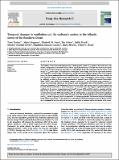Por favor, use este identificador para citar o enlazar a este item:
http://hdl.handle.net/10261/316470COMPARTIR / EXPORTAR:
 SHARE SHARE
 CORE
BASE CORE
BASE
|
|
| Visualizar otros formatos: MARC | Dublin Core | RDF | ORE | MODS | METS | DIDL | DATACITE | |

| Título: | Temporal changes in ventilation and the carbonate system in the Atlantic sector of the Southern Ocean |
Autor: | Tanhua, Toste; Hoppema, Mario; Jones, E. M.; Stöven, Tim; Hauck, Judith; González-Dávila, Melchor; Santana-Casiano, Juana MagdalenaM; Álvarez-Rodríguez, Marta CSIC ORCID; Strass, V.H. | Palabras clave: | Centro Oceanográfico de A Coruña Medio Marino Tracers Carbon cycle Southern ocean |
Fecha de publicación: | abr-2017 | Citación: | Deep-Sea Research II, 138. 2017: 26-38 | Resumen: | The Southern Ocean is the most important area of anthropogenic carbon (Cant) uptake in the world ocean, only rivalled in importance by the North Atlantic Ocean. Significant variability on decadal time-scales in the uptake of Cant in the Southern Ocean has been observed and modelled, likely with consequences for the interior ocean storage of Cant in the region, and implications for the global carbon budget. Here we use eight cruises between 1973 and 2012 to assess decadal variability in Cant storage rates in the southeast Atlantic sector of the Southern Ocean. For this we employed the extended multiple linear regression (eMLR) method. We relate variability in DIC (dissolved inorganic carbon) storage, which is assumed to equal anthropogenic carbon storage, to changes in ventilation as observed from repeat measurements of transient tracers. Within the Antarctic Intermediate Water (AAIW) layer, which is the dominant transport conduit for Cant into the interior ocean, moderate Cant storage rates were found without any clear temporal trend. In Subantarctic Mode Water (SAMW), a less dense water mass found north of the Subantarctic Front and above AAIW, high storage rates of Cant were observed up to about 2005 but lower rates in more recent times. The transient tracer data suggest a significant speed-up of ventilation in the summer warmed upper part of AAIW between 1998 and 2012, which is consistent with the high storage rate of Cant. A shift of more northern Cant storage to more southern storage in near surface waters was detected in the early 2000s. Beneath the AAIW the eMLR method as applied here did not detect significant storage of Cant. However, the presence of the transient tracer CFC-12 all through the water column suggests that some Cant should be present, but at concentrations not reliably quantifiable. The observed temporal variability in the interior ocean seems at a first glance to be out of phase with observed surface ocean Cant fluxes, but this can be explained by the time delay for the surface ocean signal to manifest itself in the interior of the ocean. | Descripción: | Article | Versión del editor: | https://www.sciencedirect.com/science/article/pii/S0967064516303046 | URI: | http://hdl.handle.net/10261/316470 | DOI: | 10.1016/j.dsr2.2016.10.004 |
| Aparece en las colecciones: | (IEO) Artículos |
Ficheros en este ítem:
| Fichero | Descripción | Tamaño | Formato | |
|---|---|---|---|---|
| Tanhua_et.al_2016_DSRII.pdf | Artículo principal | 2,05 MB | Adobe PDF |  Visualizar/Abrir |
CORE Recommender
SCOPUSTM
Citations
11
checked on 18-abr-2024
WEB OF SCIENCETM
Citations
12
checked on 27-feb-2024
Page view(s)
18
checked on 01-may-2024
Download(s)
19
checked on 01-may-2024
Google ScholarTM
Check
Altmetric
Altmetric
Este item está licenciado bajo una Licencia Creative Commons

